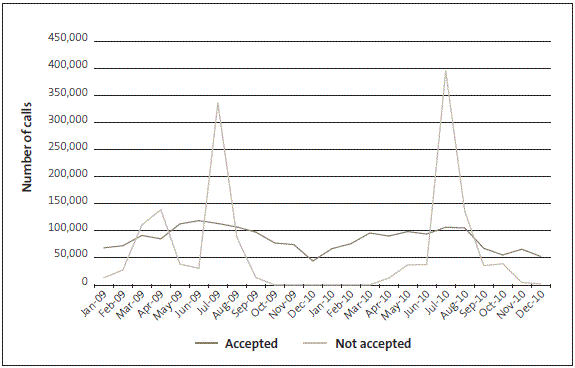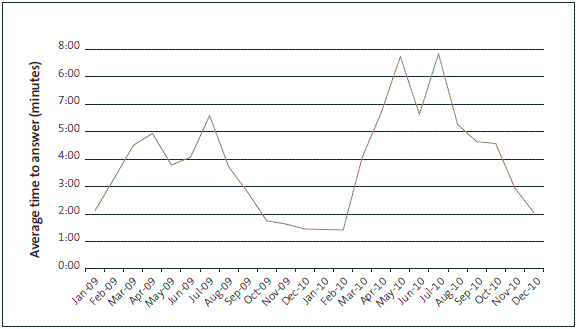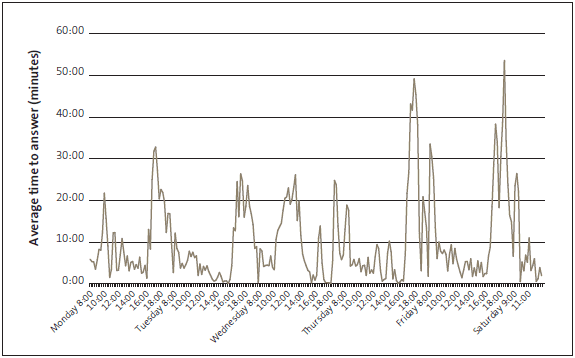Part 5: Contacting Inland Revenue by telephone
5.1
In this Part, we describe the different experiences taxpayers may have when trying to call Inland Revenue to get information about their tax obligations. We discuss:
- how long it may take to reach Inland Revenue;
- the difficulties of calling Inland Revenue from a cellphone;
- how Inland Revenue assesses the quality of its contact centre; and
- how Inland Revenue ensures that information presented to taxpayers is relevant.
5.2
We audited aspects of Inland Revenue's contact centre to test our expectation that Inland Revenue provides taxpayers with easy access to accurate information.
Summary
5.3
Inland Revenue's call volumes are highly variable, which means that different taxpayers experience different waiting times when calling Inland Revenue. High demand for contact centre services is a challenge common to overseas revenue collection agencies.
5.4
Inland Revenue will accept calls from cellphones on only some of its toll-free lines.4 In our view, not accepting calls from cellphones on all of its toll-free lines is inconsistent with Inland Revenue's strategy of making it easy to comply.
5.5
We examined how Inland Revenue assesses the quality of its telephone services. Inland Revenue has a quality assurance system in place, but it could improve this system.
5.6
Customer service specialists answering the telephones at Inland Revenue can use a script to help them answer a taxpayer's questions. In our view, Inland Revenue could improve its scripts to consistently emphasise important information that will help taxpayers to understand and comply with their tax obligations.
How long it can take to contact Inland Revenue by telephone
Inland Revenue receives a large number of telephone calls each year. During peak periods, taxpayers can find it difficult to get through to the contact centre and can wait a long time to speak with a customer service specialist.
5.7
Inland Revenue received 4.2 million telephone calls in 2009/10. These calls are spread out unevenly during the year, with call volumes at their highest during peak tax filing periods (peak periods). Because of the uneven distribution of the calls it receives, Inland Revenue has a system that allows it to roster staff on and off to help manage fluctuating call volumes. When volumes are at their highest, Inland Revenue cannot answer all of the calls that it receives.
5.8
Inland Revenue has a system that automatically "caps" the number of calls accepted by the telephone system when the number of people on hold gets too high. This means that some taxpayers will not be able to get through to Inland Revenue at certain times and will need to call back later. This can result in variable experiences for taxpayers, depending on when they call.
5.9
Figure 6 shows the monthly call volumes to Inland Revenue's general enquiries line in 2009 and 2010, by monthly number of calls accepted and not accepted. For example, in February 2010, 76,242 of 76,558 calls (99.6%) got through. In July 2010, only 106,793 of 502,345 calls (21.3%) got through.
Figure 6
Monthly call volumes to Inland Revenue's general enquiries telephone line in 2009 and 2010, showing monthly number of calls accepted and not accepted

Source: Inland Revenue.
5.10
Even during peak periods, taxpayers will experience variability in getting through to Inland Revenue. For example, of the calls made on Wednesday 14 July 2010, 88.6% got through. On the following day, however, only 11.8% of calls got through.
Once taxpayers get through to Inland Revenue's telephone system, most taxpayers get through to a customer service specialist
5.11
Most taxpayers calling Inland Revenue wait on hold until their call is answered. A small proportion of taxpayers do not wait for their call to be answered and hang up instead. When it takes longer for calls to be answered, the number of taxpayers hanging up increases.
5.12
The time it takes for a customer service specialist to answer a call varies throughout the day, week, month, and year. Figure 7 shows the average times that it took a customer service specialist to answer a call in 2009 and 2010 by month. It shows that the average time to answer a call varies throughout the year, with longer average times during peak periods.
Figure 7
Monthly average times for a customer service specialist to answer a call in 2009 and 2010

Source: Inland Revenue.
5.13
Even during peak periods, the length of time a caller must wait varies depending on when they call. Figure 8 shows a detailed breakdown of the average time to answer a call for every 15-minute period for a week in July 2010. The average time to answer a call varies from less than a minute to around 50 minutes.
Figure 8
Average time for a customer service specialist to answer a call for each 15-minute period for the week beginning 12 July 2010

Source: Inland Revenue.
Call-back service
5.14
In November 2008, Inland Revenue introduced an automated call-back service to nearly all of its toll-free numbers. The aim of the new service, called Virtual Hold, was to reduce the amount of time taxpayers spend waiting on the telephone. Callers to the toll-free numbers are told the estimated wait time, and can choose to either stay on the line or be called back. Callers who choose the call-back option retain their place in the queue and are called back when they reach the front of the queue.
5.15
The call-back option is available only when wait times reach a certain threshold. This threshold changes depending on the number of incoming calls and the number of staff available to take calls. Call backs are available only to direct dial numbers and cannot be made to cellphones (except for calls about child support), extension numbers, or international numbers.
5.16
Inland Revenue reports that the call-back service has helped reduce telephone costs and the number of abandoned calls. In 2009/10, 51% of callers accepted the call-back service when it was offered to them.
5.17
Inland Revenue's telephone system is under a lot of pressure at times. To manage this, Inland Revenue has prepared its communication channel strategy (discussed in Part 2), which it expects will help shift taxpayers away from telephones to other channels.
5.18
It is difficult to directly compare the performance of Inland Revenue's contact centre with those of overseas revenue collection agencies because of differences in tax systems and performance measures. However, an OECD report5 indicates that many overseas revenue collection agencies are also experiencing high call demand at their call centres. Like Inland Revenue, other agencies are also designing mitigation strategies to address demand.
5.19
Inland Revenue's call volumes are highly variable, which can lead to quite different taxpayer experiences in the length of time it takes to contact Inland Revenue. In our view, Inland Revenue's communication channel strategy is a sensible approach to manage the pressures on its telephone service.
Difficulties calling Inland Revenue from a cellphone
Inland Revenue will accept calls from cellphones on only some of its toll-free lines. Accepting calls from cellphones on all lines would be more consistent with its strategy of making it easy to comply.
5.20
An increasing number of taxpayers have limited access to landline phones and are relying more on cellphones as their main means of communication. Inland Revenue identifies business customers, Working for Families recipients, and students as key groups that rely on cellphones as the main way of contacting them.
5.21
Taxpayers calling from a cellphone are currently able to call only four of Inland Revenue's 31 toll-free numbers: child support, KiwiSaver, the Info Express general line, and a line used for debt collection. Some taxpayers have discovered that they can call Inland Revenue from a cellphone by calling one of these four free numbers and then asking to be transferred to the line they want to reach.
5.22
Taxpayers calling any other Inland Revenue toll-free numbers from a cellphone reach a recorded message advising them to call a different number. On all lines, except for child support, the call-back option is not available for taxpayers calling from a cellphone. Inland Revenue has had complaints from taxpayers unhappy about being unable to be called back on their cellphone.
5.23
We acknowledge that it will cost Inland Revenue more to accept cellphone calls on all its telephone lines. However, taxpayers will generally pay more to call Inland Revenue than Inland Revenue would pay to accept the call on a toll-free number.
5.24
In late 2010, Inland Revenue considered whether to accept calls from cellphones on all telephone lines. It decided against changing its policy. The main reason Inland Revenue cited was the lack of control over potential costs, given the current fiscal environment.
5.25
In our view, not accepting calls from cellphones on all of its toll-free lines is inconsistent with Inland Revenue's strategy of making it easy to comply.
Assessing contact centre quality
Inland Revenue has a system for assessing the quality of information that staff in its contact centre provide to taxpayers. We have identified where Inland Revenue can strengthen its quality assurance process.
5.26
We looked at the process that Inland Revenue uses to check the quality of information provided to taxpayers during calls. We did not audit the actual assessments of individual calls.
5.27
Inland Revenue introduced a new quality assurance process for assessing calls to the contact centre on 1 July 2010. The process assesses how well a customer service specialist responds to a taxpayer's query and the accuracy of the information provided. Inland Revenue uses this information to measure an output of service delivery, which we discuss later in this Part.
5.28
Calls taken by each customer service specialist are assessed individually each month. The number of calls assessed is determined by a risk-based assessment for each staff member. Staff who have not performed well in the past have more calls assessed than those who have performed well.
5.29
Currently, assessors select the calls they will assess from a list of a calls handled by an individual customer service specialist. In our view, there is a risk that assessors could focus on certain types of calls that may not provide a representative view of taxpayers' experiences. We consider that Inland Revenue needs to randomly select which calls to review.
5.30
Inland Revenue uses a calibration process to make sure that its assessors are assessing calls consistently. Assessors specialise in a specific subject matter that is relevant to the contact centre and are based at four sites around New Zealand.
5.31
The calibration process is generally carried out every two to three months. Staff at Inland Revenue told us that they would like to carry it out each month, but they often find that it is difficult to co-ordinate everyone and find time. In our view, calibration should be seen as an important regular event and not one that can be put off if other priorities emerge. If calibrations are not carried out regularly, assessors may apply different approaches to assessing the quality of telephone calls.
5.32
We selected the records of 60 customer service specialists to verify that an assessor had carried out checks. Not all checks had been carried out. In following up, we found that some checks were not needed because, for example, the customer service specialist was on leave. In other instances, the work had not been done. Inland Revenue does not have a system to verify that the assessors have carried out checks.
5.33
During our audit, we noted that not all telephone calls made to Inland Revenue are covered by the quality assurance process. The quality assurance process assesses only the calls handled by contact centre staff. In the 12 months to October 2010, about a quarter of calls made to Inland Revenue's toll-free numbers were answered by staff outside the contact centre. The proportion is slightly higher during peak periods. For example, in July 2010, 31% of calls were answered by staff outside the contact centre. In our view, Inland Revenue needs to extend its quality assurance process to cover all calls made to Inland Revenue. This would help to ensure that taxpayers consistently get accurate and helpful answers.
| Recommendation 4 |
|---|
We recommend that the Inland Revenue Department review its quality assurance systems and processes for its contact centre and find ways to make sure that:
|
Ensuring that information presented to taxpayers is relevant
Inland Revenue needs to update the scripts it prepares for staff to better emphasise important information that must be provided to taxpayers.
5.34
When a taxpayer calls Inland Revenue, Inland Revenue has an opportunity to inform the taxpayer of their obligations and to make it easy for the taxpayer to comply. We expected that taxpayers calling Inland Revenue about their tax obligations would be given consistent information relevant to their situation.
5.35
Inland Revenue provides scripts to all staff working in the contact centre. The scripts contain the answers to most questions taxpayers might have. This ensures that staff can provide taxpayers with correct and useful information. Inland Revenue updates its scripts when information changes. However, if a customer service specialist does not check a script after it has been updated, they may provide taxpayers with out-of-date information.
5.36
In our view, the script on starting a business is thorough, but it contains a lot of information that might be difficult to understand during a single telephone call.
5.37
To test our expectation, we carried out a "secret shopper" test of Inland Revenue's contact centre. Staff from our Office called Inland Revenue's general business number to enquire about tax obligations when starting a business. We made 10 calls at different times of the day and week. The callers recorded the response they received.
5.38
We obtained the script for starting a business before carrying out our "secret shopper" tests to see how many of the customer service specialists followed the script. We did not expect the customer service specialists to read the script word for word, but we did expect them to provide the general information contained in the script.
5.39
Our testing found that the information we received was not always consistent. We were always provided with correct information, but the amount and usefulness of the information varied. Some of the customer service specialists followed all of the script, while others provided only some of the information contained in the script.
5.40
We consider that the information given to taxpayers should be tailored to the needs of the individual taxpayer. Customer service specialists need to determine the situation of the taxpayer first and then provide information that fits that taxpayer's situation. Many of the customer service specialists asked our callers some questions about their individual situation. However, the customer service specialists did not always take the callers' situations into account when providing information. For example, one of our callers told the customer service specialist that he did not have internet access. Despite this, the customer service specialist kept referring our caller to online resources.
5.41
The amount of information that a taxpayer will need is going to vary, as will their ability to understand what they are told. As Inland Revenue reviews or updates its scripts, it needs to clearly show which information must be given to taxpayers and also consider how that information should best be delivered. In this way, Inland Revenue can ensure that taxpayers receive relevant and consistent information to help them comply with their tax obligations.
| Recommendation 5 |
|---|
| We recommend that the Inland Revenue Department, as it updates the telephone scripts its staff use, clearly set out the information that must be provided to taxpayers and consider how that information should best be delivered to them. |
4: The cost of a call on a toll-free line is charged to the receiver of the call instead of the caller. Accepting calls from cell phones is charged at a higher rate than accepting calls from landlines. The receiver of the call needs to pay for the duration of the call, even while the caller is on hold.
5: Organisation for Economic Co-operation and Development (2010), Survey of Trends and Developments in the Use of Electronic Services for Taxpayer Service Delivery.
page top
